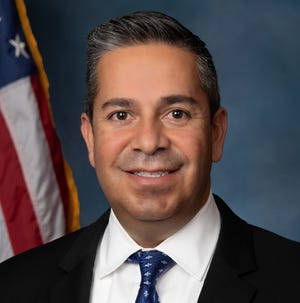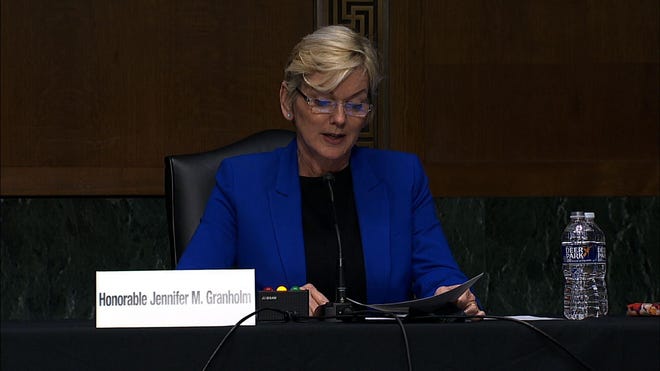As the federal government sought to shift toward less-carbon-intense forms of energy, New Mexico’s Democrat congresspeople appealed to the U.S. Department of Energy to focus efforts to develop hydrogen power in their state.
U.S. Sens. Martin Heinrich and Ben Ray Lujan and U.S. Rep. Teresa Leger Fernandez wrote a letter to U.S. Energy Secretary Jennifer Granholm calling on the DOE and administration of President Joe Biden to make New Mexico “the world’s premier center of excellence” for hydrogen energy production, research and workforce.
The congresspeople pointed to Joe Biden’s American Jobs Plan which included investments in 15 low-carbon hydrogen demonstration projects in communities across the country, including production tax credits like legislation proposed earlier this year by Heinrich in the Clean Hydrogen Production Incentives Act of 2021.
More:Facebook touts impact of its renewable energy projects in New Mexico
New Mexico’s multiple national research laboratories like Los Alamos and Sandia national labs and its renewable energy resources in the wind and solar sectors could make it an ideal location for the development of hydrogen power, the letter read.

“New Mexico has a combination of outstanding attributes that make it uniquely suited to serve as the powerhouse of the nation’s emerging clean hydrogen economy, which is already attracting significant attention and investments from industry,” read the letter.
Areas of the state known for fossil fuel production – the Permian Basin in the southeast and San Juan Basin to the northwest – could prove as hubs for clean hydrogen power as both hold strong energy infrastructures and workforces, the lawmakers argued.
More:Renewable energy industry set to increase jobs as New Mexico shifts to low-carbon power
“In your confirmation hearing, you committed to work with our delegation to develop a placebased energy transition plan that ensures that New Mexicans who have worked in fossil fuel industries are not left behind by the structural changes in the energy sector,” the letter read.
“Robust investment in New Mexico as a clean hydrogen center of excellence is a perfect opportunity to deliver on that important commitment.”
Such investments could stimulate local economies and help lead the U.S.’ transition toward renewable energy to curb pollution created by oil and gas production, they said, contending the U.S. already lagged behind China and other nations in deploying low-emission hydrogen technologies.
More:Data: Energy and oil and gas jobs remain lucrative in New Mexico, nationwide amid COVID-19

“As we work to invest in our nation’s infrastructure, rapidly cut greenhouse gas emissions, advance economic equity, and build back better, we urge you to consider New Mexico a strategic center of America’s emerging clean hydrogen economy, one that will position the United States to compete in the growing hydrogen economy worldwide,” the letter read.
Granholm announced in April at Biden’s Summit on Climate a goal of reducing the price of renewable hydrogen energy by 80 percent by 2030 to make the sector competitive with natural gas.
She said the market for a clean energy transition will grow to $23 trillion by the end of the decade and that a shift toward low-carbon energy was essential to stop pollution and combat climate change.
More:Study: New Mexico transmission projects ‘ready to go’ as leader signal shift to renewables
“By the end of this decade, we need renewables deployed at scale so that reliable, affordable, clean energy reaches people in the most populated valleys and on the remotest mountains, across the hottest deserts and coldest tundra,” Granholm said on the second day of summit on April 23, per a transcript of her remarks.
“We can lift up communities that have been knocked down. We can make good on moral debts owed to those bearing the burdens of fossil fuel pollution.”
In March, the DOE announced $2 million in federal grants to help develop hydrogen power technologies through four projects in Alabama, California, Kentucky and Utah.
More:WIPP: Electric vehicles coming to nuclear waste repository, intended to improve airflow
The projects focused on co-gasification blends waste from materials like biomass, plastic and coal feedstocks that are used to create hydrogen when combined with oxygen and steam and high pressures.
It’s an alternative to hydrogen produced using natural gas and believed to produce a cleaner form of hydrogen that can be used as energy.
“One of the important ways to achieve net-zero carbon emissions is to find innovative approaches to create clean sources of energy like hydrogen,” Granholm said.
“With these awards, we’re leaning on some of America’s most brilliant minds to turn these ideas into real solutions – at the same time creating clean energy jobs and reducing pollution in the air we breathe.”
Adrian Hedden can be reached at 575-618-7631, achedden@currentargus.com or @AdrianHedden on Twitter.







